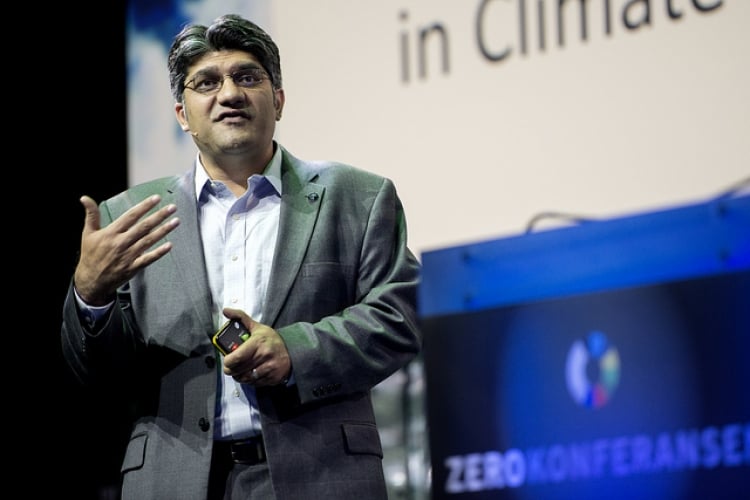
The US is now taking the stance on climate change its European counterparts have been demanding for years, the Department of Energy’s Jigar Shah told Energy-Storage.news in a wide-ranging interview.
The Inflation Reduction Act and its US$369 billion package of support and incentives for the US’ clean
energy industry has already had a huge impact on the market just six months on from its passing.
Enjoy 12 months of exclusive analysis
- Regular insight and analysis of the industry’s biggest developments
- In-depth interviews with the industry’s leading figures
- Annual digital subscription to the PV Tech Power journal
- Discounts on Solar Media’s portfolio of events, in-person and virtual
As director of the Department of Energy’s Loan Programs Office (LPO) with responsibility for up to US$100 billion in loans and more in other forms of support, Shah is one of the senior figures in enabling the US’ scale-up of its clean energy technology sectors.
This is an extract of an interview article with Shah which appeared in Vol.34 of PV Tech Power, Solar Media’s quarterly technical journal for the downstream solar industry. Every edition includes ‘Storage & Smart Power,’ a dedicated section contributed by the team at Energy-Storage.news.
Response to European policymakers’ complaints
In light of the Inflation Reduction Act and the uptick in US investment it has spurred, senior European policymakers called in late 2022 for immediate action to prevent an outflow of investment from its battery ecosystem, with some saying it should have gone as far as filing a complaint about the Act with the World Trade Organisation (WTO).
Those calls resulted in Europe’s response, its Green Industrial Plan, revealed in February 2023.
Shah’s view on this minor war of words is clear: “Several years ago the European Union was demanding that the US get in the game and be more aggressive on climate change. Now that we’re being more aggressive, people might not be used to that.”
“The US has been in the innovation business on climate change for years but now it’s firmly in the commercialisation business, and that is only a good thing.”
US$100 billion-plus in loan requests
The LPO, which Shah has headed up since March 2021, had at last count US$120 billion in loan requests covering all energy sectors with ‘Advanced Vehicles & Components’ (including battery production) the the biggest single sector at US$20-30 billion, based on LPO infographics.
This shows how much emphasis is being placed on the battery sector and the EV market that is driving it. Shah says that the country is already on track to achieve its stated goals here.
“It’s now a foregone conclusion that we will achieve this administration’s goal of 50% of vehicles being EVs by 2030. We’ve counted at least 800GWh of battery manufacturing being announced which is
how much you need to hit that target. The trends started before my time in office but have certainly ramped up in the last few years,” he said.
When it comes to circularity of the lithium-ion supply chain, recycling appears to be much further ahead than re-use, i.e. second life, from the standpoint of coming to the LPO for loans to commercialise. Although Shah is keen to emphasise the department has no preference.
“Battery recycling is represented in our loan requests. The vast majority of second life companies that we’ve talked to are still in the beta testing phase, and coming to us is really the last step of commercialisation,” he said.
“What’s important to highlight is that the US government, unlike other governments, does not favour any particular technology. We want both sectors to give it a go as long as they can raise private
capital. The LPO is government-enabled but private sector-led.”
Lithium-ion’s dominance of the market
The vast majority of even new gigafactories are set to build lithium-ion batteries to serve the EV and, to a lesser extent, ESS markets, which is largely reflected in the DOE’s financial support given out to-date. Shah is nonetheless confident that the technology’s dominance will start to wane in the downstream grid-scale ESS market.
“Lithium-ion NMC batteries will not dominate forever. The amount of innovation in the battery space is so high that it is hard to see any of the existing incumbent technologies in their current form having
dominant market share in 7-10 years. It could be sodium-ion, it could be solid-state technologies, I don’t know who’s going to win,” he says.
“But I do think that the automotive industry will price out the utility-scale industry in lithium-ion, so you will see a rapid shift away from lithium-ion in the utility sector towards other chemistries, which is happening as we speak.”
This is an extract of a feature which appeared in Vol.34 of PV Tech Power, Solar Media’s quarterly technical journal for the downstream solar industry. Every edition includes ‘Storage & Smart Power,’ a dedicated section contributed by the team at Energy-Storage.news. Subscribe to the journal here, or get the journal included as part of a subscription to PV Tech Premium, here.
Energy-Storage.news’ publisher Solar Media will host the 5th Energy Storage Summit USA next week, on the 28-29 March 2023 in Austin, Texas. Featuring a packed programme of panels, presentations and fireside chats from industry leaders focusing on accelerating the market for energy storage across the country. For more information, go to the website. Energy-Storage.news reporter Cameron Murray will be attending.

